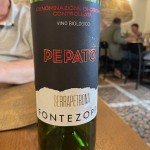By Neil Duarte
Now that the summer travel season is upon us, some lucky readers will be traveling to Italy and probably spend at the least part of their Italian visit in beautiful Rome. Recently, my wife and I made our almost annual trip to Italy and decided to spend our entire time in Rome. We had been in Rome several times, but had never really stayed in a neighborhood and mingled with the locals.
After looking at all of the many possibilities, we chose Trastevere, a quaint neighborhood just across the Tiber River from the main areas of ancient Rome. Trastevere had a large number of less formal tratteria and osteria eating places, all within walking distance.
In the past in Rome, wine selection — other than the expensive “ristorante” with a lengthy wine list — generally consisted of white wine Frascati or red wine Sangiovese. Frascati is a blend of Malvasia Bianco, Grechetto, Bombino and Trebbiano, and is a nice simple wine. The Sangiovese was generally very young and ordinary.
Today you will find much more variety in the house wines or even brief wine lists in the trattorias. In many of these, the house wines offered come in regular 750 ml bottles rather than liter jugs poured from a demijohn. In comparison to wine by the bottle prices at restaurants in the U.S., the bottle prices are quite reasonable in the 18-30 Euro range.
For the primi course, the menus typically offer pasta: cacio e pepe, carbonara, amatriciana and sometimes gricia. Cacio e pepe is made primarily from pecorino cheese and black pepper served over spaghetti or tagliatelle. Carbonara is made with eggs, bacon or guanciale (cured pork jowl). Amatriciana is made from pecorino cheese, black pepper, pancetta or bacon and dried chilies. Italians do not add crème to any of these. We never saw gricia on any of the menus where we ate in Trastevere. In several trattorias the house wine that paired well with these pastas was Montepulciano d’Abbruzzo. At our favorite trattoria, Il Tulipiano Nero, we drank Pozzo d’Albe, a 100% Montepulciano from Cantina Bove. This wine was recommended by Gianmarco, the excellent head waiter at Il Tulipiano Nero.
The secondi (entree course) varied greatly. We enjoyed maialino (roast baby pork) at La Tavernaccia da Bruno accompanied by a local Cesanese grape wine whose name I didn’t get. At Trattoria Evo my wife had duck breast while I enjoyed superb pistachio-crusted pork. This was accompanied by a bottle of Pepato, a Vernacia Nera di Serrapetrona from Cantina Fontezoppa in Marche. I visited this winery many years ago and really liked this wine when I wrote about it.
You shouldn’t miss some of the “street food” when you’re there. At Trapizzino we tried the pizza pocket, an unbelievable creation with a pizza pocket filled with a meatball and sauce (they also have eggplant parmigiana and other fillings). My wife had a glass of the Caniolo di Candia white house wine while I enjoyed a glass or so of Foretano, a 2020 Lazio Cesanese from Azienda Carlo Noro. Another must is Suppli, where they feature deep fried rice balls with red sauce called Suppli and excellent Pizza Marinara al Taglio. Plan to take this back to your lodgings or eat in the street.
The variety of wines available at every trattoria we visited was a pleasant surprise. The Caniolo di Candia white (I had a sip) was really nice, and the Cesanese wines were excellent.
So don’t worry about the wines available at the trattorias in Rome anymore: the selection has greatly improved.
- Traffic in Rome, always busy!
- This pedestrian bridge connects Trastevere to the central sections of ancient Rome.
- Gianmarco, headwaiter at Il Tulipano Nero…
- …served us this Montepulciano d’Abruzzo, their house wine.
- Another wine we enjoyed.
- A Vernacia Nera di Serrapetrona we enjoyed at Trattoria Evo.










